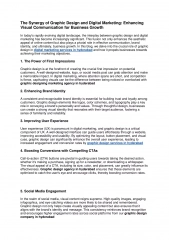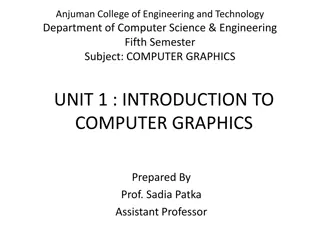Understanding Raster Graphics in Computer Graphic Design
Raster graphics, also known as bitmap images, consist of a grid of pixels representing colors, viewable on screens or printed media. They are stored in various file formats and are characterized by width, height, and color depth. Contrastingly, vector graphics are line-based and offer scalability without loss of quality. Raster graphics are widely used in printing and prepress industries, though converting between raster and vector formats results in some data loss. The term "raster" originates from the Latin "rastrum," denoting a rake and reflecting the scanning process of electron beams in CRT monitors. Modern computers employ raster graphics displays for efficient pixel mapping and color rendering, essential for graphic processing units.
Download Presentation

Please find below an Image/Link to download the presentation.
The content on the website is provided AS IS for your information and personal use only. It may not be sold, licensed, or shared on other websites without obtaining consent from the author. Download presentation by click this link. If you encounter any issues during the download, it is possible that the publisher has removed the file from their server.
E N D
Presentation Transcript
RASTER RASTER GRAPHICS GRAPHICS [ COMPUTER GRAPHIC ]
RASTER GRAPHICS RASTER GRAPHICS In computer graphics, a raster graphics or bitmap image is a dot matrix data structure that represents a generally rectangular grid of pixels (points of colour), viewable via a monitor, paper, or other display medium. Raster images are stored in image files with varying formats. A bitmap is a rectangular grid of pixels, with each pixel's color being specified by a number of bits.[1] A bitmap might be created for storage in the display's video memory or as a device-independent bitmap file. A raster is technically characterized by the width and height of the image in pixels and by the number of bits per pixel (or color depth, which determines the number of colors it can represent).
RASTER GRAPHICS RASTER GRAPHICS The printing and prepress industries know raster graphics as contones (from "continuous tones"). The opposite to contones is "line work", usually implemented as vector graphics in digital systems.[3] Vector images can be rasterized (converted into pixels), and raster images vectorized (raster images converted into vector graphics), by software. In both cases some information is lost, although vectorizing can also restore some information back to machine readability, as happens in optical character recognition.
RASTER GRAPHICS RASTER GRAPHICS The smiley face in the top left corner is a raster image. When enlarged, individual pixels appear as squares. Enlarging in further, they can be analyzed, with their colors constructed by combining the values for red, green and blue.
ETYMOLOGY ETYMOLOGY The word "raster" has its origins in the Latin rastrum (a rake), which is derived from radere (to scrape). It originates from the raster scan of cathode ray tube (CRT) video monitors, which paint the image line by line by magnetically steering a focused electron beam.[4] By association, it can also refer to a rectangular grid of pixels. The word rastrum is now used to refer to a device for drawing musical staff lines.
APPLICATIONS APPLICATIONS Most modern computers have bitmapped displays, where each on-screen pixel directly corresponds to a small number of bits in memory. The screen is refreshed simply by scanning through pixels and coloring them according to each set of bits. The refresh procedure, being speed critical, is often implemented by dedicated circuitry, often as a part of a graphics processing unit. An early scanned display with raster computer graphics was invented in the late 1960s by A. Michael Noll at Bell Labs, but its patent application filed February 5, 1970 was abandoned at the Supreme Court in 1977 over the issue of the patentability of computer software.
IMAGE STORAGE IMAGE STORAGE Most computer images are stored in raster graphics formats or compressed variations, including GIF, JPEG, and PNG, which are popular on the World Wide Web. Three-dimensional voxel raster graphics are employed in video games and are also used in medical imaging such as MRI scanners.























